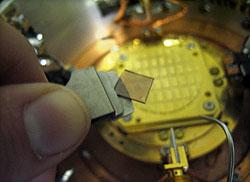By Jessica Brodsky
Transcending traditional academic boundaries is key to continued progress at the intersection of nanotechnology, biotechnology and other scientific fields, but the organizational structure at many institutions hinders that kind of collaboration.
Scientists and industry leaders called for creative solutions that make it easier for researchers from different fields to work together, during a February 18 symposium at the American Association for the Advancement of Science meeting in Boston.
“There is something about interdisciplinary research that somehow is going to help us solve problems and think about issues that we simply can’t solve and think about within disciplinary boundaries,” said Sarah Kaplan, an associate professor of strategic management at the University of Toronto. “Reorganizing science is going to be about new practices, new processes — not just separate stand-alone organizations, but rethinking how people do their work in everyday ways.”
Researchers and students at the University of Pennsylvania's Nano/Bio Interface Center cross disciplinary boundaries to create new materials. Credit: NBIC/Univ. of PennsylvaniaDepartmental divisions and ingrained ways of thinking act as barriers to interdisciplinary research, but many organizations have found ways around those roadblocks. More and more, institutions and research firms are creating an infrastructure that supports multidisciplinary work. In 2005, for example, 287 firms worldwide had the capacity to do research at the intersection of biotechnology and nanotechnology. By 2011 that number was up to more than 500, according to findings by technology management expert Elicia Maine of Simon Fraser University in British Columbia.
One model of successful integration is the Joint Center for Artificial Photosynthesis, or JCAP, a program of the California Institute of Technology and Lawrence Berkeley National Laboratory dedicated to creating a plant-mimicking device that converts sunlight, water and carbon dioxide to fuel.
Instead of being divided into traditional research groups, the center’s 160 members work in multidisciplinary teams, each dedicated to solving one specific problem.
“The model is an experiment in innovation,” said JCAP director Nathan Lewis, a chemist at Caltech. “When you send graduate students or postdocs or staff into the building, their loyalty is to the project, not to the research group.”
The program is housed in two buildings. A buddy system allows researchers in one building to share their work with colleagues in the other. Every six months, buddies visit with each other to discuss the projects in their respective buildings. The contributions of postdoctoral fellows and graduate students also are crucial to the program’s success.
Students are often at the core of interdisciplinary research, Kaplan said, describing her work at the Nano/Bio Interface Center at the University of Pennsylvania. Faculty members served as advisors, but the students were the ones to train across disciplines and negotiate the differences between departments. The students learned enough of the jargon and culture of differing fields that they could communicate effectively with researchers whose native science-language was different from their own.
“They were the ones not just learning the pidgin or creole, but deeply understanding the different ways of thinking,” Kaplan said.
Tapping into the strengths of young researchers is one of the main ways forward for interdisciplinary research, the researchers said.
“Postdocs and graduate students are also the future,” said engineer Robert Langer of the Massachusetts Institute of Technology, who studies effective ways to deliver drugs to various parts of the body. “You want people who are going to walk through walls to take their discoveries and get them out to the world.”
Jessica Brodsky is a junior at Brown University studying science and society with a focus in science communication. She writes for the Science and Research section of the Brown Daily Herald and has an interest in science education, science policy and the intersection of science and art. Email her at Jessica_Brodsky@brown.edu.

